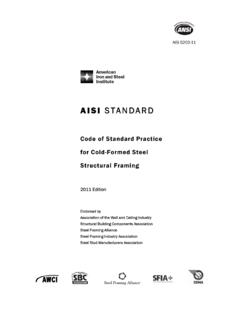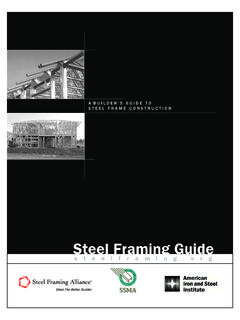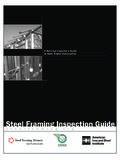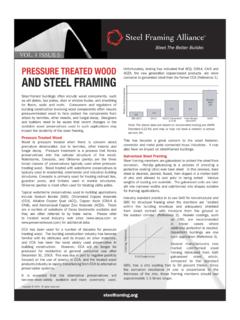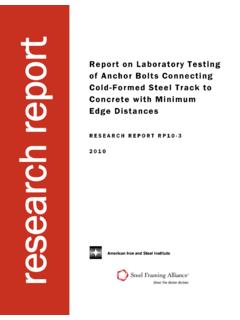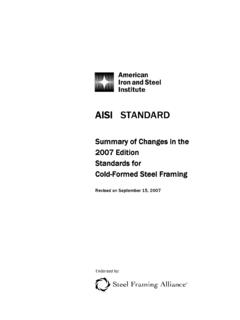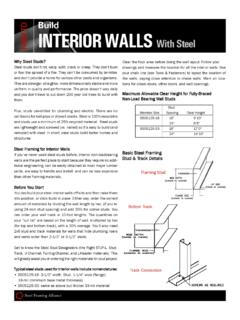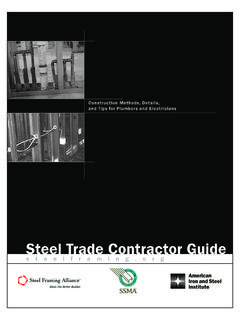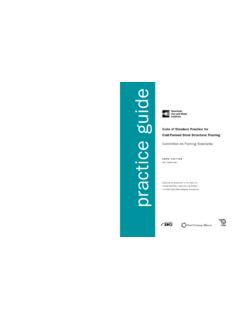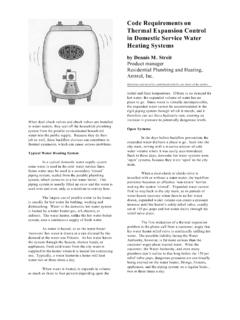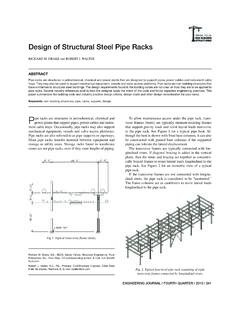Transcription of THERMAL DESIGN AND CODE COMPLIANCE FOR COLD …
1 THERMAL DESIGN AND code COMPLIANCE FOR cold - formed steel WALLS steel Framing Alliance 1201 15th Street, NW, Suite 320 Washington, DC 20005 August 2008 THERMAL DESIGN and code COMPLIANCE for cold - formed steel Walls 1 Acknowledgements This report updates the THERMAL DESIGN Guide for Exterior Walls originally published in 1995 by the American Iron and steel Institute (AISI). Support for this update was provided by the steel Framing Alliance (SFA) and the steel Stud Manufacturer s Association (SSMA). The author is Mark Nowak of Newport Partners LLC. Appreciation is extended to Larry Williams of SFA for providing oversight throughout the project, Don Allen for coordinating review with SSMA members, and the SFA THERMAL Task Group for their comments.
2 We are also grateful to the authors of the 1995 guide who laid the foundation for this update, and to Jonathan Humble of AISI who helped retrace some of the important codes and standards development issues from the early 1990s to today. Last, the author is thankful to Matt Hawkins of Newport Partners LLC for formatting assistance. THERMAL DESIGN and code COMPLIANCE for cold - formed steel Walls 2 Contents Introduction THERMAL DESIGN and code COMPLIANCE for cold - formed steel Background and Use of this Section 1 THERMAL Properties of CFS Section 2 Pathways for code Section 3 The Performance Simulation Instructions for Using the Simulated Performance Section 4 Prescriptive COMPLIANCE Determining the THERMAL Characteristics for code Correction Factor Existing Test Instruction for Using the Prescriptive Options in Section 5 Innovative Appendix A Contact information for COMPLIANCE Appendix B Alternative calculation Zone
3 Modified Zone Appendix C U-Factors in the 2008 California Title 24 energy THERMAL DESIGN and code COMPLIANCE for cold - formed steel Walls 3 Tables Table 1: U-Factors for Selected cold - formed steel Wall Table 2: System Improvements with High Potential for a Vented Crawl Space in Climate Zone Table 3: System Improvements with High Potential for Slab-On-Grade in Climate Zone Table 4: Summary of Simulation Table 5: 2006 IECC Climate Zone 2 Residential Wall Table 6: cold - formed steel Correction Table 7: U-Factor and R-Values Calculated by Correction Factor Method for Selected Table 8: Clear Wall Assembly Test Table 9: Whole-Wall Test Results of cold - formed steel Assemblies with 22% to 25% Table 10: 2006 IECC code Requirements for Residential cold - formed steel Table 11: 2006 IECC code Requirements for Commercial Wood and cold - formed steel Table 12: California Title 24 Requirements for Low-Rise Residential Table 13: California Requirements for Selected Commercial Building Figures Figure 1: IECC Climate Zone Map.
4 11 Figure 2: California Climate Zones Figure 3: Warm Wall DESIGN with Continuous Exterior Insulation and No Cavity THERMAL DESIGN and code COMPLIANCE for cold - formed steel Walls 4 INTRODUCTION THERMAL DESIGN AND code COMPLIANCE FOR cold - formed steel WALLS BACKGROUND AND OBJECTIVES In the early 1990s cold - formed steel (CFS) began making gains in the residential construction market. In response, the American Iron and steel Institute (AISI) sponsored ground-breaking research to develop recommendations for the DESIGN of walls constructed from cold - formed steel . The 1995 AISI THERMAL DESIGN Guide for Exterior Walls resulted from this early work. The 1995 AISI DESIGN Guide has been the industry s primary reference source on the THERMAL DESIGN of cold - formed steel walls since its release.
5 Although the research in the original guide is still valid, the residential framing environment has undergone significant changes, mostly relating to recent research findings and the adoption of more stringent energy efficiency requirements, in the past decade. The need to update the 1995 DESIGN guide is driven by these six industry changes: 1. Wider use of the performance approach for achieving code COMPLIANCE ; 2. Availability of new test and research data; 3. An on-going shift in codes and standards away from clear wall assembly factors to more accurate and detailed framing factors; 4. The move from R-11 to R-13 as the code minimum cavity insulation in walls; 5. A better understanding of how to calculate an assembly s U-Factor and effective R-Value; and 6.
6 Climate zone designations used in codes and standards have changed since the 1990s. With any type of wall framing, heat flows directly through the cavity AND directly through the frame. Both heat flow paths must be considered when taking a whole-wall performance approach. THERMAL DESIGN and code COMPLIANCE for cold - formed steel Walls 5 This document has two main objectives: 1. Provide the most up-to-date information on the THERMAL performance of cold -framed steel walls, and 2. Provide the information necessary for designers or builders to comply with modern energy codes, specifically information on appropriate whole-wall R-Values and/or U-Factors. Use of this Document This document is designed to meet users differing needs.
7 Individuals interested in whole-building performance may need detailed information on simulation tools or calculation methods, while others may need information on specific THERMAL properties of a wall system to comply with a local or state code . Thus, this document is set up as follows: Section 1 is the quick reference section for those looking for the THERMAL properties of commonly-used CFS wall sections. This section contains a table of U-Factors derived from the Zone Method calculation technique. Section 2 describes the two main approaches codes use for COMPLIANCE the Performance or Prescriptive Options. This section provides the user with a basic understanding of how energy codes are structured and the advantages and disadvantages of specific code COMPLIANCE options.
8 Section 3 addresses the Simulated Performance Approach, an option in most energy codes for evaluating an entire building s energy use. This evaluation method offers flexibility to CFS assemblies for meeting and exceeding codes in a cost-effective manner. Section 4 describes the prescriptive requirements in codes and how to meet or exceed them. This is the most-often used option for code COMPLIANCE . Section 4 also provides test data and U-Factors for selected assemblies that are important for both the prescriptive and performance COMPLIANCE options in codes and standards. Section 5 discusses innovative methods evolving to increase the efficiency of cold - formed steel wall assemblies. Informative appendices are provided containing contact information of software developers for the Whole Building Simulation Method and a discussion of alternative U-Factor calculation methods.
9 THERMAL DESIGN and code COMPLIANCE for cold - formed steel Walls 6 SECTION 1 THERMAL PROPERTIES OF CFS ASSEMBLIES R-Values and U-Factors are the THERMAL property calculations a builder or designer evaluates a building with to meet energy code requirements. The R-Value is a measure of the THERMAL resistance of a material or assembly. The U-Factor is the inverse of the R-Value, or the THERMAL conductance. When a code specifies an R-Value of insulation that must be met, you simply add the R-Values of the wall cavity insulation and any exterior continuous insulation on the wall assembly. The resulting wall insulation R-Value total must be equal to or greater than the R-Value listed in the building code . The situation becomes more complex when a code or standard specifies a U-Factor for the entire wall assembly instead of requiring an R-Value just for insulation.
10 Section 4 discusses the calculation methods used to determine U-Factors. But, Table 1 is a quick reference table for builders, designers and those only interested in U-Factors necessary to comply with codes and standards. Table 1: U-Factors for Selected cold - formed steel Wall Assemblies Stud Size Stud Spacing Cavity Insulation Continuous Insulation Assembly U-Factor 24 R-13 None 24 R-13 R-3 24 R-13 R-5 24 R-15 None 24 R-15 R-3 24 R-15 R-5 24 R-19 None 24 R-19 R-5 24 R-21 None 24 R-21 R-5 THERMAL DESIGN and code COMPLIANCE for cold - formed steel Walls 7 The presented U-Factor values may be used for any type of building ( , commercial or residential).
